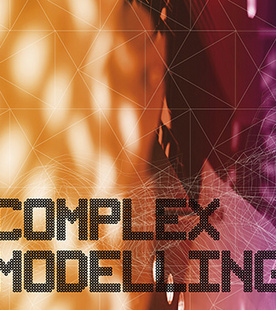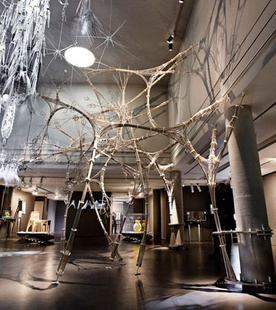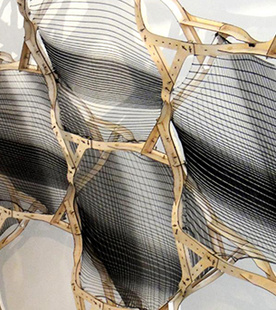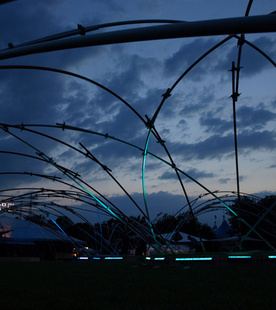Transmissive Assemblies

The installation Transmissive Assemblies concentrates upon two qualities that are particular to fibre reinforced composites: translucency in a structural element, and the ability to gain stiffness locally through forming and folding. Taking point of departure from preceding architectural experiments focused upon these qualities - exemplified by Renzo Piano’s Mobile Sulphur Extraction Facility (1965) - the project asks how a modern composite sandwich might be designed to modulate the transmission of light in a controlled manner through strategic material variation.
The aim of this experiment is to establish methods for designing with synthetic materials. Practice already possesses models for composites that synthesise the inter-related behaviour of constituent components, but we do not have models for activating and varying these components, and the qualities associated with them, within the design process. What might these models be like, and how do they allow us to think about materialization and specification in new ways?
Background and Context
This project furthers prior research into methods for designing with synthetic materials. Synthetic materials afford opportunities for specification, simulation and feedback not available in found materials, through design parameters that relate to different scales and material components. These parameters are often standardized, however they could also be opened up to design. This project explores these ‘preliminary operations’ – the digital and physical processes that inform and lead up to materialization.
It develops a generative design method that connects a set of models related to structure, core and skin, which is used to introduce variation into a tiling, translucent and geometrically stiffened GFRP panel system. To achieve differentiated light transmission through the composite sandwich, different parts of the whole are strategically activated – the hanging points, which find the best available condition, or the core, which is perforated, or the skin, which folds locally to increase stiffness.

Process
The materials used within this structure are common construction materials. The foam core is a highly insulative and light weight DIAB PET structural foam, and both thermoplastic and thermoset composite skins have been explored. Before their consolidation into a sandwich, each of these materials undergo working processes specified by the digital model, using tools that include a CNC router and an industrial robotic arm, as well as vacuum bagging.
The digital design process links together a number of different generative models, each related to one of the constituent materials within the sandwich assembly. Over a time-based process, these models trigger one another, and transmit information between themselves, until a stable condition is achieved that satisfies a design intention regarding light conditions as well as structural stability.
Experimental approach
Transmissive Assemblies orients its engagement with experiment through the notion of concentration. Through isolation, preparation and manipulation, often resulting in highly artificial conditions, an experiment develops the ability to concentrate a particular phenomenon. This process of concentration is one aspect that distinguishes experiment from, for example, observation. In Transmissive Assemblies, concentration occurs around the idea that each constituent material within the composite sandwich might be active and variable, in both physical and digital realms. This sets up a further set of specific experiments, related to material performance, material testing, and digital modeling.






